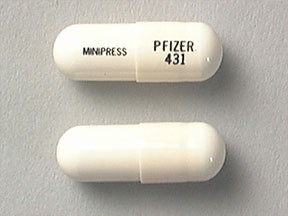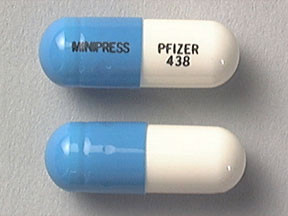PRAZOSIN - ORAL
PHONETIC PRONUNCIATION: (PRAZ-oh-sin)
COMMON BRAND NAME(S): Minipress
GENERIC NAME(S): prazosin HCl
Uses
USES: Prazosin is used with or without other medications to treat high blood pressure. Lowering high blood pressure helps prevent strokes, heart attacks, and kidney problems. Prazosin belongs to a class of medications called alpha blockers. It works by relaxing and widening blood vessels so blood can flow more easily.
How to use PRAZOSIN - ORAL
HOW TO USE: Take this medication by mouth with or without food, usually two or three times daily or as directed by your doctor. If stomach upset occurs, take with food or milk. The dosage is based on your age, medical condition and response to therapy. Prazosin can occasionally cause sudden fainting after the first dose and anytime that your dose is increased. To reduce your risk of fainting, the first dose prescribed by your doctor will be the smallest dose available. You should take this first dose as you are going to bed. This will decrease the possibility of fainting. Your dose may be gradually increased. Take your first new dose at bedtime when your dose is increased unless directed otherwise by your doctor. Use this medication regularly in order to get the most benefit from it. To help you remember, take it at the same time(s) each day. If you are taking this medication for high blood pressure, it is important to continue taking it even if you feel well. Most people with high blood pressure do not feel sick. It may take up to several weeks before the full benefit of this drug takes effect. Do not stop taking this medication without first consulting your doctor. Some conditions may become worse when the drug is abruptly stopped. Your dose may need to be gradually decreased. Tell your doctor if your condition worsens (such as your routine blood pressure readings increase).
Side Effects
Precautions
Interactions
Overdose
Images

- color
- white
- shape
- oblong
- imprint
- MINIPRESS, PFIZER 431

- color
- white
- shape
- oblong
- imprint
- MINIPRESS, PFIZER 438
Reviews
Faq for PRAZOSIN - ORAL
Prazosin is used to treat high blood pressure (hypertension) and to improve the symptoms of benign prostatic hyperplasia (enlarged prostate).
Prazosin belongs to a class of medications called alpha blockers. It works by relaxing the blood vessels, allowing blood to flow more easily through them. This helps lower blood pressure and improve urine flow in men with an enlarged prostate.
Yes, prazosin has also been found to be effective in treating post-traumatic stress disorder (PTSD) related nightmares and sleep disturbances.
The common side effects of prazosin include dizziness, drowsiness, headache, constipation, and weakness. These side effects typically occur during the first few days of treatment and may improve with continued use.
Prazosin is generally not recommended for use in pregnant women, as its safety during pregnancy has not been fully established. It should only be used if the potential benefits outweigh the potential risks.
If you miss a dose of prazosin, take it as soon as you remember. However, if it is close to the time for your next dose, skip the missed dose and resume your regular dosing schedule. Do not double the dose to catch up.
Prazosin may interact with certain medications, including other blood pressure-lowering drugs, erectile dysfunction medications, and medications for mental/mood disorders. It is important to inform your healthcare provider about all the medications you are taking to avoid potential interactions.
Prazosin starts working within the first few doses, but it may take several weeks to see the full benefit of the medication. It is important to continue taking prazosin as directed by your doctor, even if you feel well.
Disclaimer
IMPORTANT: HOW TO USE THIS INFORMATION: This is a summary and does NOT have all possible information about this product. This information does not assure that this product is safe, effective, or appropriate for you. This information is not individual medical advice and does not substitute for the advice of your health care professional. Always ask your health care professional for complete information about this product and your specific health needs.




No Reviews Yet